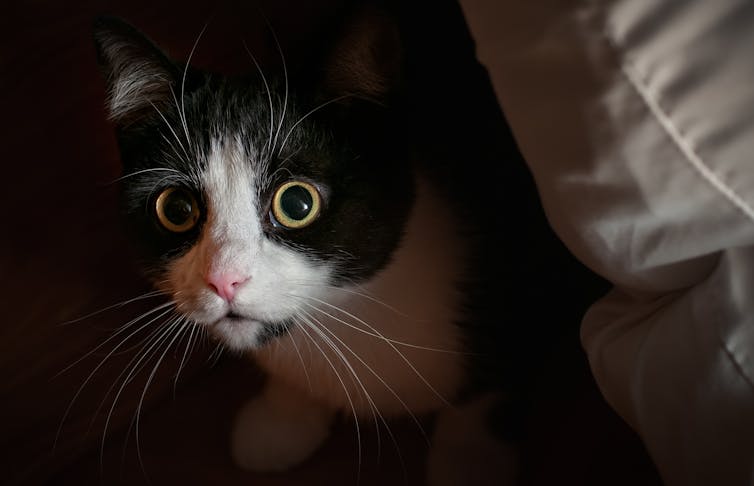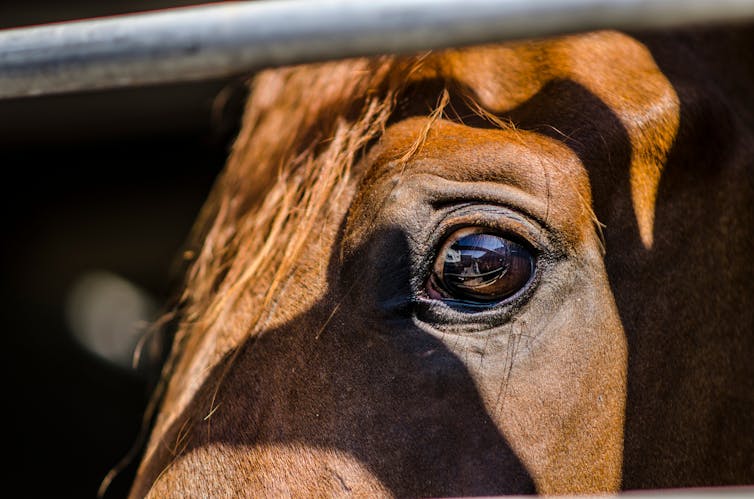Animal welfare: how to keep your pet happy during thunderstorms and fireworks

Bang! dezy/Shutterstock
Fireworks are a brilliant way to celebrate special occasions such as New Year’s Eve and Guy Fawkes Night, as well as big sporting events and independence days – right? Not if you happen to be an animal. All animals, domesticated and wild, are hardwired by evolution to find loud noises frightening. It is an automatic response to an unidentified threat, which may cause the animal to bolt before the brain has had time to process the information the ears are presenting. The only way in which the response can be changed or reduced is by training, desensitisation or habituation to the noise.
It’s easy to see why fireworks and thunder are so frightening to animals. They are loud, sudden and send shock waves through the air and the ground. In technical terms they activate the auditory startle response. You might expect that dogs, cats and other domestic animals would be better able to tolerate the scary nature of fireworks since they are used to sudden loud noises, but many dogs and cats spend Bonfire Night and New Year’s Eve in a state of terror. A study in the UK found that up to 49% of owners reported that their dogs were afraid of noises, and fireworks were the number one cause. Thunderstorms and gunshots were the next two most common issues.
But the news might not be all bad for fearful animals. We can sometimes help our pets to overcome fear, or prevent them from developing it, with training and management techniques. Dogs and cats that have been properly introduced to unexpected events of all kinds in the early part of their lives may not be worried by loud noises.
The most important time for socialising dogs with people and other dogs, and for getting them used to other “scary stuff”, is the first 12 weeks of life, known as the socialisation period. For kittens, the window is even shorter at up to seven weeks. During this time, they need to get used to the idea that unexpected, loud, bright, confusing things may happen and they are nothing to worry about.
If you have been able to do this with your pet during those first crucial weeks, then you may have no problems. If for any reason you have not done that, or your pet is frightened in spite of all your efforts, there are still a number of things you can do to help them during fireworks or thunderstorms.

Dogs and cats often feel more secure if they have a small, enclosed space to hide in when they are afraid, so providing a den can help. This can be as simple as an area between two armchairs, or a small table with a blanket draped over the top. Cats will often get under the bed or behind the sofa. For really severe cases you may want to ask your vet to prescribe medication and to recommend a pet behaviour counsellor to help with desensitising the animal to sounds. This is not something to be done without professional guidance as you can make things worse if you don’t do it correctly.
Make sure that both cats and dogs are indoors well before the fireworks start, to prevent them running away in a panic and getting lost or injured. If you can, it’s best to stay at home with your companion animal to give them added security and help them to stay calm.
Larger animals, including horses, can be more difficult to deal with. Being flight animals, their reaction to loud noises is to run as fast as possible in the opposite direction – and they will not stop to look what’s in their way. As with all animals, desensitisation to the loud noise beforehand is the best solution.

Managing horses during fireworks events is crucial, but it can be a difficult decision whether to leave your horse out or bring it into the stable. Some prefer to run around outdoors while others feel more secure inside. Either way, it is very important to ensure that fencing is secure and there is nothing that could cause injury. Staying with the horse will also ensure it stays safe.
We usually know when our pets are afraid, but we don’t see the fear that farm animals or wild animals can experience. We can help our pets overcome their fear or give them some comfort with training and management techniques, but there is little we can do to reduce the distress of wild animals. If we really are a nation of animal lovers, we need to tackle the problems caused by fireworks. Perhaps reducing the decibel level of displays to a more reasonable level, or even removing the bangs altogether is the answer. Would fireworks be any less beautiful if they were silent?![]()
Jan Hoole, Lecturer in Biology, Keele University
This article is republished from The Conversation under a Creative Commons license. Read the original article.
Most read
- Keele University partners with Telford College and NHS to teach new Nursing Associate apprenticeship in Shropshire
- Emotion aware chatbot developed by Keele scientists offers transformative potential for mental health care
- First study of its kind sheds new light on Britain’s ‘forgotten’ World War Two decoy sites
- Keele cardiologist travels to Ethiopia to improve care for heart patients
- Keele academic wins prestigious prize for short story set in Stoke-on-Trent
Contact us
Andy Cain,
Media Relations Manager
+44 1782 733857
Abby Swift,
Senior Communications Officer
+44 1782 734925
Adam Blakeman,
Press Officer
+44 7775 033274
Ashleigh Williams,
Senior Internal Communications Officer
Strategic Communications and Brand news@keele.ac.uk.

